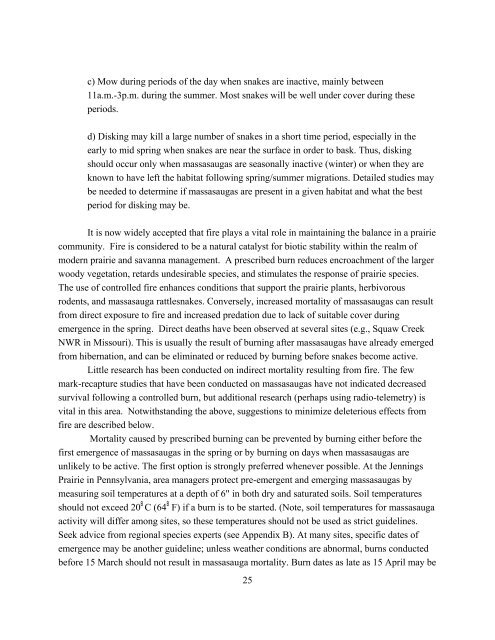The Eastern Massasauga Rattlesnake: - U.S. Fish and Wildlife Service
The Eastern Massasauga Rattlesnake: - U.S. Fish and Wildlife Service
The Eastern Massasauga Rattlesnake: - U.S. Fish and Wildlife Service
You also want an ePaper? Increase the reach of your titles
YUMPU automatically turns print PDFs into web optimized ePapers that Google loves.
c) Mow during periods of the day when snakes are inactive, mainly between<br />
11a.m.-3p.m. during the summer. Most snakes will be well under cover during these<br />
periods.<br />
d) Disking may kill a large number of snakes in a short time period, especially in the<br />
early to mid spring when snakes are near the surface in order to bask. Thus, disking<br />
should occur only when massasaugas are seasonally inactive (winter) or when they are<br />
known to have left the habitat following spring/summer migrations. Detailed studies may<br />
be needed to determine if massasaugas are present in a given habitat <strong>and</strong> what the best<br />
period for disking may be.<br />
It is now widely accepted that fire plays a vital role in maintaining the balance in a prairie<br />
community. Fire is considered to be a natural catalyst for biotic stability within the realm of<br />
modern prairie <strong>and</strong> savanna management. A prescribed burn reduces encroachment of the larger<br />
woody vegetation, retards undesirable species, <strong>and</strong> stimulates the response of prairie species.<br />
<strong>The</strong> use of controlled fire enhances conditions that support the prairie plants, herbivorous<br />
rodents, <strong>and</strong> massasauga rattlesnakes. Conversely, increased mortality of massasaugas can result<br />
from direct exposure to fire <strong>and</strong> increased predation due to lack of suitable cover during<br />
emergence in the spring. Direct deaths have been observed at several sites (e.g., Squaw Creek<br />
NWR in Missouri). This is usually the result of burning after massasaugas have already emerged<br />
from hibernation, <strong>and</strong> can be eliminated or reduced by burning before snakes become active.<br />
Little research has been conducted on indirect mortality resulting from fire. <strong>The</strong> few<br />
mark-recapture studies that have been conducted on massasaugas have not indicated decreased<br />
survival following a controlled burn, but additional research (perhaps using radio-telemetry) is<br />
vital in this area. Notwithst<strong>and</strong>ing the above, suggestions to minimize deleterious effects from<br />
fire are described below.<br />
Mortality caused by prescribed burning can be prevented by burning either before the<br />
first emergence of massasaugas in the spring or by burning on days when massasaugas are<br />
unlikely to be active. <strong>The</strong> first option is strongly preferred whenever possible. At the Jennings<br />
Prairie in Pennsylvania, area managers protect pre-emergent <strong>and</strong> emerging massasaugas by<br />
measuring soil temperatures at a depth of 6" in both dry <strong>and</strong> saturated soils. Soil temperatures<br />
should not exceed 20 B C (64 B F) if a burn is to be started. (Note, soil temperatures for massasauga<br />
activity will differ among sites, so these temperatures should not be used as strict guidelines.<br />
Seek advice from regional species experts (see Appendix B). At many sites, specific dates of<br />
emergence may be another guideline; unless weather conditions are abnormal, burns conducted<br />
before 15 March should not result in massasauga mortality. Burn dates as late as 15 April may be<br />
25

















